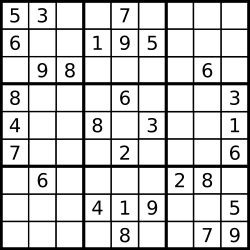【LeetCode】36. Valid Sudoku
Difficulty: Medium
More:【目录】LeetCode Java实现
Description
https://leetcode.com/problems/valid-sudoku/
Determine if a 9x9 Sudoku board is valid. Only the filled cells need to be validated according to the following rules:
- Each row must contain the digits
1-9without repetition. - Each column must contain the digits
1-9without repetition. - Each of the 9
3x3sub-boxes of the grid must contain the digits1-9without repetition.

A partially filled sudoku which is valid.
The Sudoku board could be partially filled, where empty cells are filled with the character '.'.
Example 1:
Input: [ ["5","3",".",".","7",".",".",".","."], ["6",".",".","1","9","5",".",".","."], [".","9","8",".",".",".",".","6","."], ["8",".",".",".","6",".",".",".","3"], ["4",".",".","8",".","3",".",".","1"], ["7",".",".",".","2",".",".",".","6"], [".","6",".",".",".",".","2","8","."], [".",".",".","4","1","9",".",".","5"], [".",".",".",".","8",".",".","7","9"] ] Output: true
Example 2:
Input:
[
["8","3",".",".","7",".",".",".","."],
["6",".",".","1","9","5",".",".","."],
[".","9","8",".",".",".",".","6","."],
["8",".",".",".","6",".",".",".","3"],
["4",".",".","8",".","3",".",".","1"],
["7",".",".",".","2",".",".",".","6"],
[".","6",".",".",".",".","2","8","."],
[".",".",".","4","1","9",".",".","5"],
[".",".",".",".","8",".",".","7","9"]
]
Output: false
Explanation: Same as Example 1, except with the 5 in the top left corner being
modified to 8. Since there are two 8's in the top left 3x3 sub-box, it is invalid.
Note:
- A Sudoku board (partially filled) could be valid but is not necessarily solvable.
- Only the filled cells need to be validated according to the mentioned rules.
- The given board contain only digits
1-9and the character'.'. - The given board size is always
9x9.
Intuition
Mehtod 1: Use three hashSet (rowSet, colSet, boxSet) to store digits in each row/ column/ sub-box.
Details:
i: 1 ->9 j: i ->9
rowSet: a[i][j]
colSet: a[j][i]
boxSet:
For a given sub-box, we can traverse a 3*3 sub-box using just j: a[ j/3 ] [ j%3 ]
We has 9 sub-boxes, so we can use i to switch in different sub-boxes: a[i/3*3+j/3][i%3*3+j%3]
Mehtod 2: Use only one hashSet to store a[i][j] in three ways.
Encode a[i][j] as a[i][j]+"r"+i to represent a[i][j] in row i;
Encode a[i][j] as a[i][j]+"c"+j to represent a[i][j] in colum j;
Encode a[i][j] as a[i][j]+"box"+i/3+j/3 to represent a[i][j] in box-i/3-j/3;
Solution
//Method 1
public boolean isValidSudoku(char[][] board) {
for(int i=0; i<9; i++){
HashSet<Character> rowSet = new HashSet<>();
HashSet<Character> colSet = new HashSet<>();
HashSet<Character> boxSet = new HashSet<>();
for(int j=0; j<9; j++){
if(board[i][j]!='.' && !rowSet.add(board[i][j]))
return false;
if(board[j][i]!='.' && !colSet.add(board[j][i]))
return false;
if(board[i/3*3+j/3][i%3*3+j%3]!='.' && !boxSet.add(board[i/3*3+j/3][i%3*3+j%3]))
return false;
}
}
return true;
}
//Method 2: easier to understand
public boolean isValidSudoku(char[][] board) {
HashSet<String> set = new HashSet<>();
for(int i=0; i<9; i++){
for(int j=0; j<9; j++){
if(board[i][j]!='.'){
String num = String.valueOf(board[i][j]);
if(!set.add(num+"r"+i) || !set.add(num+"c"+j) || !set.add(num+"box"+i/3+j/3))
return false;
}
}
}
return true;
}
Complexity
Time complexity : O(n)
Space complexity : O(n)
What I've learned
1. Learn how to use i, j to represent elements in different rows and columns and sub-boxes.
2. For a given sub-box, we can traverse a 3*3 sub-box using just j: a[ j/3 ] [ j%3 ]
3. It's clever to store elements in a hashSet by convert elements to String.
More:【目录】LeetCode Java实现





 浙公网安备 33010602011771号
浙公网安备 33010602011771号